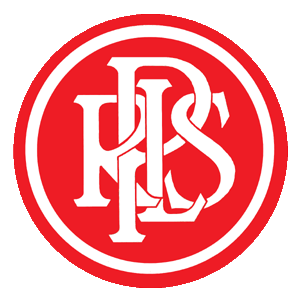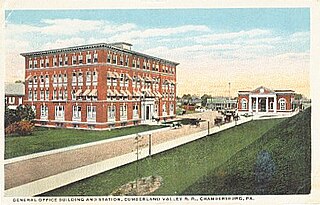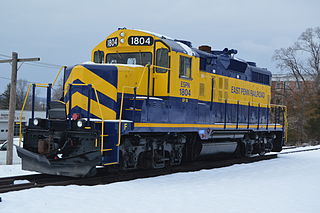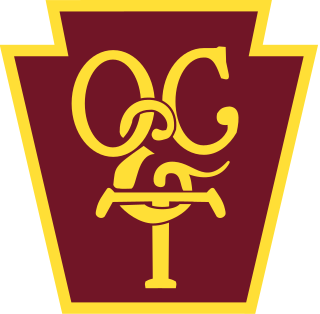
Kutztown is a borough in Berks County, Pennsylvania, United States. It is located 18 miles (29 km) southwest of Allentown and 17 miles (27 km) northeast of Reading. As of the 2010 census, the borough had a population of 5,012. Kutztown University of Pennsylvania is located just outside the borough limits to the southwest.
The Pennsylvania Railroad, legal name The Pennsylvania Railroad Company also known as the "Pennsy", was an American Class I railroad that was established in 1846 and headquartered in Philadelphia, Pennsylvania. It was named for the commonwealth in which it was established. By 1882, Pennsylvania Railroad had become the largest railroad, the largest transportation enterprise, and the largest corporation in the world. Its budget was second only to the U.S. government.
The Lehigh Valley Railroad was a railroad built in the Northeastern United States to haul anthracite coal from the Coal Region in Pennsylvania. The railroad was authorized on April 21, 1846, for freight and transportation of passengers, goods, wares, merchandise and minerals in Pennsylvania and the railroad was incorporated and established on September 20, 1847, as the Delaware, Lehigh, Schuylkill and Susquehanna Railroad Company. On January 7, 1853, the railroad's name was changed to Lehigh Valley Railroad. It was sometimes known as the Route of the Black Diamond, named after the anthracite it transported. At the time, anthracite was transported by boat down the Lehigh River. The railroad ended operations in 1976 and merged into Conrail along with several northeastern railroads that same year.

The Reading Company was a Philadelphia-headquartered railroad that provided passenger and commercial rail transport in eastern Pennsylvania and neighboring states that operated from 1924 until its acquisition by Conrail in 1976.

The Pennsylvania-Reading Seashore Lines was a railroad that operated in South Jersey in the 20th century. It was created in 1933 as a joint consolidation venture between two competing railroads in the region: the Pennsylvania Railroad and the Reading Company.
Early Electro-Motive Corporation switchers were built with Winton 201-A engines. A total of 175 were built between February 1935 and January 1939. Two main series of locomotives were built, distinguished by engine size and output: the straight-8, 600 hp (450 kW) 'S' series, and the V12, 900 hp (670 kW) 'N' series. Both were offered with either one-piece cast underframes from General Steel Castings of Granite City, Illinois, denoted by 'C' after the power identifier, and fabricated, welded underframes built by EMC themselves, denoted by 'W'. This gave four model series: SC, SW, NC and NW. Further developments of the 900 hp (670 kW) models gave model numbers NC1, NC2, NW1, and NW1A, all of which were practically indistinguishable externally from the others, as well as a pair of unique NW4 models for the Missouri Pacific Railroad and a solitary, twin-engined T transfer locomotive model built for the Illinois Central Railroad.
The Wilmington and Western Railroad is a freight and heritage railroad in northern Delaware, operating over a former Baltimore and Ohio Railroad (B&O) branch line between Wilmington and Hockessin. The 10.2-mile (16.4 km) railroad operates both steam and diesel locomotives. It was added to the National Register of Historic Places as a national historic district in 1980. Wilmington & Western serves one customer for revenue service, and interchanges with CSX Transportation at Landenberg Junction, Delaware

The Reading Blue Mountain and Northern Railroad, sometimes shortened to Reading and Northern Railroad, is a regional railroad in eastern Pennsylvania. Its headquarters is in Port Clinton. The RBMN provides freight service on 300 miles (480 km) of track. Its mainline consists of the Reading Division between Reading and Packerton and the Lehigh Division between Lehighton and Dupont. Its main freight cargo is anthracite coal.
The Allentown Railroad was a railway company in the United States. It was incorporated in 1853 with the original intention to connect the Central Railroad of New Jersey at Allentown with the Pennsylvania Railroad's main line across the Allegheny Mountains. Though grading was almost entirely finished, the project was halted by the Panic of 1857, and the completion of the East Pennsylvania Railroad in 1859 made the Allentown Railroad's proposed line largely redundant. As a result, track was never laid on most of the line. The small portion that did became the Allentown branch of the Reading Company from Topton to Kutztown, and was nominally owned by the Allentown Railroad until the Reading dissolved it in 1945 to simplify corporate bookkeeping. Other Reading subsidiaries also laid track on parts of the right-of-way elsewhere along the route. The short line Allentown & Auburn Railroad continues to operate freight service on the Topton to Kutztown route.
The Stewartstown Railroad is a heritage railroad in Stewartstown, Pennsylvania. Chartered in 1884 by local interests in the Stewartstown area and opened in 1885, the Stewartstown Railroad survives today in very much original condition and retains its original corporate charter.

The Cumberland Valley Railroad was an early railroad in Pennsylvania, United States, originally chartered in 1831 to connect with Pennsylvania's Main Line of Public Works. Freight and passenger service in the Cumberland Valley in south central Pennsylvania from near Harrisburg to Chambersburg began in 1837, with service later extended to Hagerstown, Maryland, and then extending into the Shenandoah Valley to Winchester, Virginia. It employed up to 1,800 workers.

East Penn Railroad is a short-line railroad that operates a number of mostly-unconnected lines in the U.S. states of Pennsylvania and Delaware. Except for two industrial park switching operations, all are former Pennsylvania Railroad or Reading Company lines, abandoned or sold by Conrail or its predecessors.

The Buffalo and Susquehanna Railroad was a railroad company that formerly operated in western and north central Pennsylvania and western New York. It was created in 1893 by the merger and consolidation of several smaller logging railroads. It operated independently until 1929, when a majority of its capital stock was purchased by the Baltimore and Ohio Railroad. At the same time, the B&O also purchased control of the neighboring Buffalo, Rochester, and Pittsburgh Railway. The Baltimore and Ohio officially took over operations of both roads in 1932.

The Oil Creek and Titusville Railroad is a tourist railroad that runs from Titusville to Rynd Farm north of Oil City in the U.S. state of Pennsylvania. The Oil Creek and Titusville Lines is the designated operator of the railroad, as well as the freight carrier on the line.
The Three Rivers Rambler is an excursion train in Knoxville, Tennessee along the Tennessee River. The train is operated by the Knoxville and Holston River Railroad, a subsidiary of Gulf and Ohio Railways.

The Lehigh Line is a railroad line in central New Jersey, Northeastern Pennsylvania, and the Lehigh Valley region of eastern Pennsylvania. It is owned and operated by the Norfolk Southern Railway. The line runs west from the vicinity of the Port of New York and New Jersey via Conrail's Lehigh Line to the Susquehanna River valley at the south end of the Wyoming Valley Coal Region. Administratively, it is part of Norfolk Southern's Keystone Division and is part of the Crescent Corridor. As of 2021 the line is freight-only, although there are perennial proposals to restore passenger service over all or part of the line.

The Colebrookdale Railroad, also known as the Secret Valley Line, is a tourist railroad located in the U.S. state of Pennsylvania. The railroad operates between Boyertown in Berks County and Pottstown in Montgomery County.
The Allentown branch, also known as the Kutztown branch or the Kutztown industrial track, is a railway line in Pennsylvania. It runs 4 miles (6.4 km) from a junction with the Reading Line at Topton to Kutztown. The line was built in 1870 by the Allentown Railroad and was part of the Reading Company system until 1976. The Kutztown Transportation Authority has owned the line since 2000. The Allentown and Auburn Railroad is the current operator.
Huntingdon and Broad Top Mountain Railroad and Coal Co. 38 is a preserved 2-8-0 "Consolidation" type steam locomotive. It was built by Baldwin in April 1927 for use on the Huntingdon and Broad Top Mountain Railroad and Coal Company in south central Pennsylvania in the United States, which commonly used the locomotive to pull short-distance freight trains, as well as occasional passenger trains, until the railroad shut down operations in 1954. The locomotive was subsequently acquired by the Rail City Historical Museum in Sandy Creek, New York for static display. In the late 1960s, No. 38 was sold to the Livonia, Avon and Lakeville Railroad in Lakeville, New York, who restored the locomotive to operating condition to pull their excursion trains. In 1977, the locomotive was sold again to the Gettysburg Railroad, which used the locomotive to pull their own tourist trains until 1986, when No. 38 was transferred to the Knox and Kane Railroad to be used there. The locomotive had been removed from service in 1989 for a long-term overhaul that was eventually completed, but it never returned to service for the Knox and Kane. After No. 38 fell victum to an arson-related roundhouse fire in 2008, it was sold at an auction to Alan Maples for the Everett Railroad. As of 2023, the Everett Railroad is restoring No. 38 to operating condition for use in excursion service alongside 2-6-0 No. 11.











